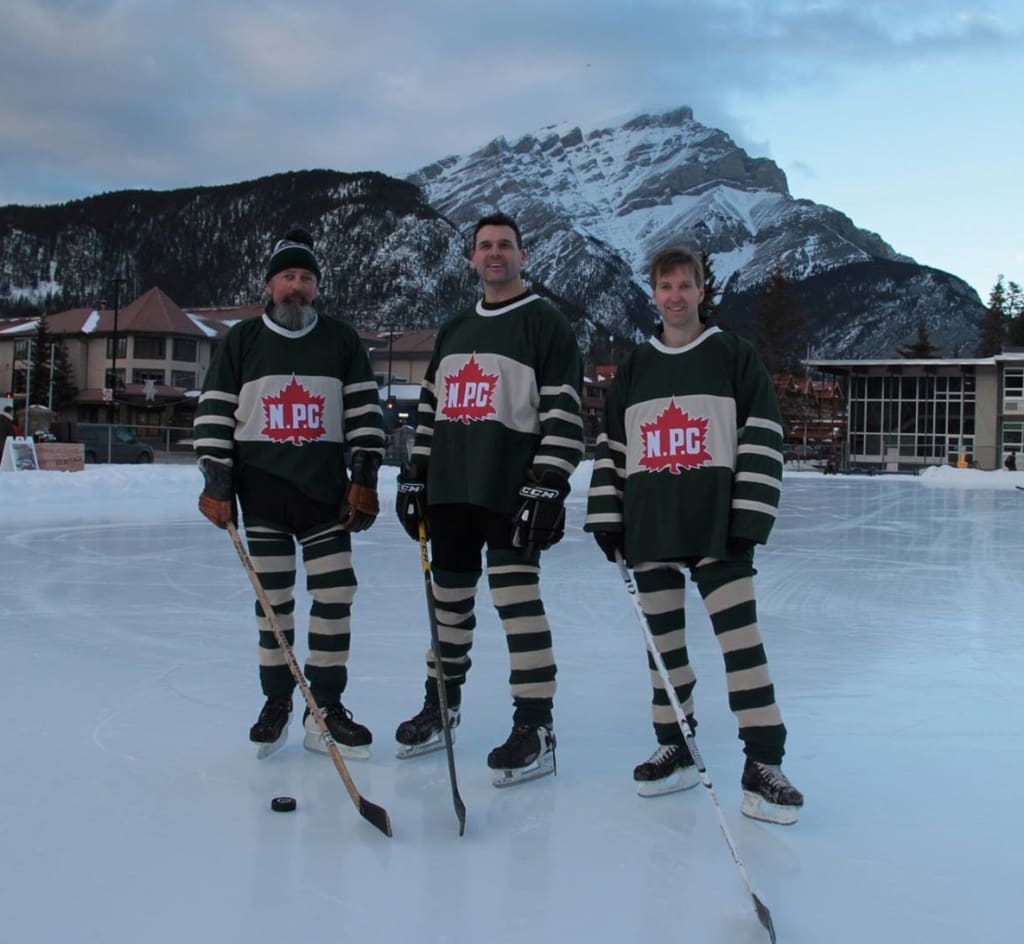Building a Backyard Ice Rink
A Step-by-step for First-timers

A crisp, clear winter morning heralded by the hollow squawk of skate blades on new ice and the clackity-clatter of hockey sticks and the boom of pucks punctuating their caroms from a border of new boards. The season of ice and snow has arrived, celebrated through construction and use of a backyard skating rink. If you are interested in building your own ice rink, the fabrication of a simple one should commence sooner than you might think.
1. In autumn, once the vegetable tops have been removed from the garden and composted and before freeze-up, time need be taken to rake the bare earth smooth.
2. Next, collecting 1” x 8” planks and some sturdy wooden stakes of about 50 centimeters in length, is called for. The wood can be recovered from old woodpiles in landfills or from other such locations or simply purchased from a lumber yard.
3. The planks are laid flat around the desired perimeter of the rink then tipped on edge and slid back and forth lengthwise to ensure that the entire lower surface is in contact with the soil beneath each of them. (note: The planks will then remain on edge for the remainder of the construction steps.) This step will save time, effort and water when the actual ice-making begins.
4. Ensuring that all the boards are in contact at the adjoining ends, a post hammer is then needed to pound the stakes into the soil on the outside of the planks so that these stakes are in continuous contact with the flat outer surfaces of the planks and, so that the tops of the stakes are flush with, or just below the top edge of these perimeter boards. Three or four support stakes per plank should suffice.
5. Using nails that are about two centimeters longer than the thickness of the planks, the planks are then fastened to the stakes. Use of one or two nails per stake is plenty and nailing from the inside of the rink boards into the stakes is advised. The back side of the stakes is supported, by an assistant, holding the post hammer tight to the stakes, while one pounds nails. This will help to avoid knocking the stakes askew during the nailing process.
6. Next, the soil inside the rink needs be raked smooth one last time and then watered lightly throughout the days until freeze up. Again, this will save on patchwork and water lost through leakage, during the stages of ice-making that follow. Some rink-makers prefer to line the ice-surface and the gap between soil and boards with polyethylene to stop water from escaping but that is an added expense both financially and time-wise. It is really not necessary if care is taken in all of the previous steps listed above.
7. When the first permanent snow flies there will be a temptation to rush outside and begin the ice-making process. To avoid disappointment, one mustn’t ‘blink’ until daytime temperatures have remained below the freezing mark for at least two weeks. Instead, a soccer game on the proposed project surface is in order. This will pack the snow, making it easier to flood, thus cutting down on the amount of water that one needs, to get the ice started. It will also give the ice a clean white surface when the project is complete.
8. As alluded to, the next step is to put some water on the packed snow by placing a hand-controlled spray attachment on the business end of the hose. Beginning with a medium spray at the farthest corner of the rink from the water source and walking backward while spraying, away from the watered area, minimizes trudging through the wet snow and making fossil footprints that sometimes take forever to smooth over. After a good soaking, and the hose has been disconnected and drained thoroughly it should be stored indoors. Time need be allowed for the new rink-ice to thoroughly solidify. This watering step should be repeated five or six times over a two-day period. It can be repeated more often if the temperature is – 20 degrees Celsius or below. As the ice begins to build, the medium spray can be modified to a heavier stream. One needs to be cautious that the more forceful spray does not situate in one spot for long, eroding a difficult-to-fill hole in the thin ice.
9. Once the ice surface is smooth and level and at least two centimeters up on the entire inside wall, a final flood of hot water can be showered onto the ice. The garden hose application method works for this but, if a clean, open top, 45-gallon, oil drum is available, the ‘dump’ method of hot-flooding yields some wonderful results. The entire volume of hot water in the barrel is flushed, by tipping the barrel, onto the ice surface all at once, with care not to let the barrel fall heavily onto the boards or the new ice surface. It would be advisable to have a strong, young assistant handy to help with this step. A 60 cm X 60 cm piece of plywood should also be placed on the ice to dissipate the forceful stream as it gushes out of the barrel. The plywood piece must be picked up quickly after the initial surge of water, before the liquid begins to freeze. The hot water helps the different layers, formed in cold flooding, to bond to one another. If hot water can’t be used, applying a cold-flood on a warm day will achieve the same desired effect.
10. Of course, there is ongoing maintenance involved with having a backyard ice-rink. Snow has to be scraped from the ice after blizzards or heavy use. Cold-floods on warmer days or hot-floods at least once per week, depending on usage, need be applied. But, for some, the project will be complete at this point and can be enjoyed for the remainder of the winter, pretty much as is. For others, however, particularly those who are of creative persuasion, tempera paints may be applied to a freshly flooded surface to fashion stars and moons and rainbows or various hockey lines or images around the ice. A fine mist or a drizzle from a watering-can should be used to cover the paint, once it dries. Icing over the paint several times and letting it freeze each time between coverings is recommended. Finally, application of a cold-flood and then a final hot-flood to the entire surface before the skating season resumes, is essential.
Constructing an ice rink is much like driving to Disneyland. It is always fun to stop for lunch and to see sights, like the Grand Canyon, along the way. That journey is full of wonderful memories, as is building boards and performing late-night floods and maintenance on a backyard rink. But in both adventures, the burning question always remains, “Are we there yet?” So, when you wake up on a Saturday morning in the middle of January, and look out of the kitchen window and see the sheen of fresh ice right there in your own back yard, it is not unlike finally being welcomed aboard the Disneyland Express and, meeting ‘Mickey’ for the very first time. Enjoy your winter.
About the Creator
John Oliver Smith
Baby, son, brother, child, student, collector, farmer, photographer, player, uncle, coach, husband, student, writer, teacher, father, science guy, fan, coach, grandfather, comedian, traveler, chef, story-teller, driver, regular guy!!






Comments
There are no comments for this story
Be the first to respond and start the conversation.